

Sound Words: Examples of Onomatopoeia. Onomatopoeia is a fun, linguistic tool used in literature, songs and advertisements. Now that you've seen examples of the individual words, consider the following examples of onomatopoeia words in use. Take a look at the different onomatopoeia examples in Todd Rundgren's song, appropriately named Onomatopoeia. Effective Teacher-Child Interactions. Carol Dweck: The power of believing that you can improve. How can parents and teachers best educate young children?
What principles can both teachers and parents bring to the education of very young children? Gillian Craig, who was part of the Learning Time with Shaun and Timmy writing team, explains. As teachers and parents, we follow certain principles in our roles. Often though, these principles overlap and all we need to do is recognise and reinforce these areas.
Ask (the right) questions When my daughter came out of her class one day shortly after her course started, I asked her, 'What did you do in class today? '. Although my daughter is only two years old, (and more experienced parents than me would not have asked such a broad question to start with), questioning our children at any age about what they have done in class is a natural thing to do. Similarly, a child’s artwork can provide a prompt for asking questions: 'What (or who) is it? ' Teachers also want their students to reflect on their lessons, but with young children especially, this is a learned skill. Reinforce desirable behaviour. 9 Things You Need to Know About Play (and Preventing Challenging Behavior!) — Challenging Behavior.
Over and over again I’ve seen examples of intentional support for a child’s play result in language spurts, increased attention span, social skills, friendships formed, and dramatic reductions or the elimination of the challenging behavior…sometimes even when the behavior was occurring at other times of the day.
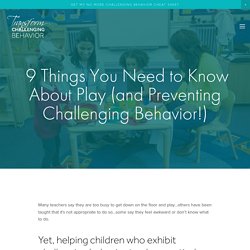
Curious? Read on… 1. Importance of play for babies & children. Australian Government Department of Education and Training (2009).
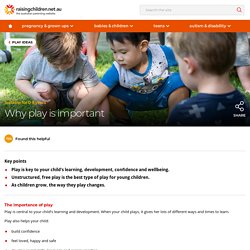
Belonging, being and becoming: The early years learning framework for Australia. Canberra: Commonwealth of Australia. Retrieved 19 June 2019 from Cole-Hamilton, I. (2011). Getting it right for play: The power of play: An evidence base. Fleer, M. (2013). Ginsburg, K.A. (2007). Lester, S., & Russell, W. (2010). Lui, C., Solis, S.L., Jensen, H., Hopkins, E.J., Neale, D., Zosh, J.M., Hirsh-Pasek, K., & Whitebread, D. (2017). How young children learn English through play. As we release Learning Time with Timmy – our first app for early-years learners of English – Danitza Villarroel, a teacher on our Learning Time with Shaun and Timmy course in Chile, explains the importance of learning through play, and offers a few tips for teachers new to this age group.
Teaching English to pre-school children can be daunting for teachers new to this age group. Young children have shorter attention spans than older children and adults, and they're still learning their mother tongue. But teaching these learners can be enormously rewarding once you've taken a few basic principles on board. Video and young learners 1. Some ideas for the kinds of video suitable for young learners are also given.
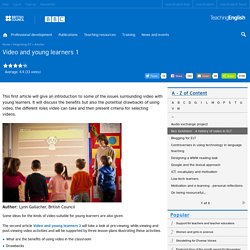
The second article Video and young learners 2 will take a look at pre-viewing, while-viewing and post-viewing video activities and will be supported by three lesson plans illustrating these activities. What are the benefits of using video in the classroomDrawbacksRole of videoCriteria for selecting videoVideo typesFurther reading and bibliography What are the benefits of using video in the classroom? Learners aged 3 - 8. Carol Read: The secret of working with children. How can young children best learn languages? The British Council's Tracey Chapelton explains how parents of young children can lay the foundations for success. Children's brains are highly active Your child is unique, but what all children have in common is natural curiosity and an innate ability to learn.
Kuhl states that babies and young children are geniuses at acquiring a second language. 'Babies', she says, 'can discriminate all the sounds of all languages... and that's remarkable because you and I can't do that. We're culture-bound listeners. By exposing children to other languages at an early age, you are giving them the opportunity to tap into their natural ability to hear and distinguish the sounds of other languages, and their capacity to make sense of what they are hearing. 6 Types of Play: How Children's Play Becomes More Social.
Play is a serious business.
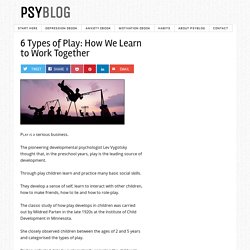
The pioneering developmental psychologist Lev Vygotsky thought that, in the preschool years, play is the leading source of development. Through play children learn and practice many basic social skills. They develop a sense of self, learn to interact with other children, how to make friends, how to lie and how to role-play. The classic study of how play develops in children was carried out by Mildred Parten in the late 1920s at the Institute of Child Development in Minnesota. How Children Learn to Talk. Have you ever wondered how children learn to talk?
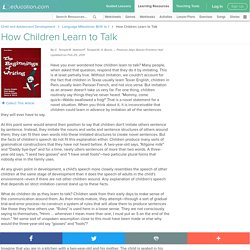
Many people, when asked that question, respond that they do it by imitating. This is at least partially true. Without imitation, we couldn't account for the fact that children in Texas usually learn Texan English, children in Paris usually learn Parisian French, and not vice versa. But imitation as an answer doesn't take us very far. How young children learn English as another language. By Opal Dunn, educational consultant and author Introduction Young children are natural language acquirers; they are self-motivated to pick up language without conscious learning, unlike adolescents and adults.
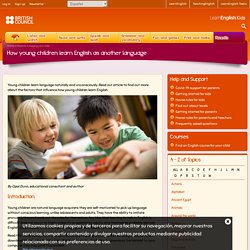
They have the ability to imitate pronunciation and work out the rules for themselves. Any idea that learning to talk in English is difficult does not occur to them unless it’s suggested by adults, who themselves probably learned English academically at a later age through grammar-based text books. Read the notes below about young children learning English as another language.
The advantages of beginning early. Getting the right balance between adult-led and child-initiated learning. As an early years practitioner you will know the importance of creating the right balance between adult-led and child-initiated learning.
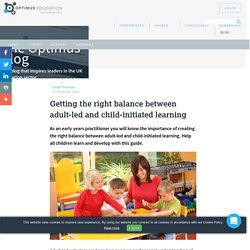
Total physical response - TPR. Where is it from?

How can I use it in class? When should I use it? Why should I use it in the classroom? A few useful variations Are there any disadvantages with using TPR? How can young children best learn languages? Early Child Language Development – Future Learn – British Council. Enabling environment. Speaking strategies and activities. Developing social and emotional well-being.